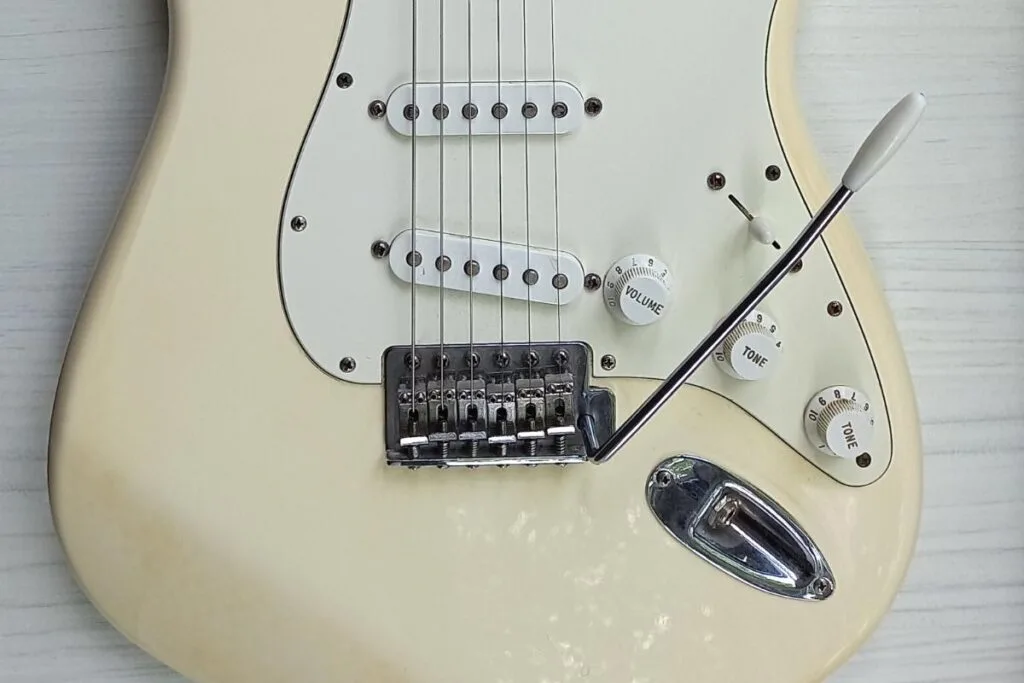As a musician with over 15 years of experience, I’ll occasionally come across people mistaking the difference between tremolo vs vibrato.
Don’t get me wrong – it’s an easy mistake to make as both can sound quite similar, and it’s also not helped by the music industry (I’m looking at you, “tremolo arm”!).
So, I thought I’d put this article together to fully show you the differences between the two.
Tremolo and vibrato are both what’s known as “modulation” effects, meaning that they both change your guitar’s signal to produce an effect.
But, here’s the key difference between them:
Tremolo is a modulation up and down in volume, whereas vibrato is a modulation up and down in pitch.
Sounds simple, right?
But, did you know that there’s actually two types of tremolo for guitar? And that your guitar’s tremolo arm isn’t actually used for tremolo?
Let’s take a look at detailed look at tremolo vs vibrato, and listen to some audio examples to get a better understanding of these often misunderstood effects.
The two types of tremolo
Tremolo is a method of playing guitar that creates a “trembling” effect on the sound. It comes from the Italian word tremolando which means “to tremble”.
With electric guitar, there’s actually two types of tremolo that you need to know about: tremolo effects and tremolo picking.
Tremolo effects, usually just called tremolo, refers to an effect that changes the volume of your guitar up and down. This effect is produced by either an effects pedal or amp settings.
Tremolo picking, on the other hand, is the rapid picking of a single note or multiple notes. To do this, the guitar pick is rapidly moved up and down on the string to create the quick “trembling” sound effect.
What does tremolo sound like?
Though both of these techniques are technically tremolo, they both have very different sounds.
The tremolo effect, either from a guitar amp or effects pedal, sounds like a rhythmic stuttering of sound. As it’s an electrical based effect, the timings of the rise and fall of the volume can be adjusted and is usually evenly spaced.

It’s used to add movement and interest to a guitar part, and can help give a stronger sense of rhythm to a song.
For example, listen to the song “How Soon is Now?” by The Smiths. The first thing you’ll hear is a guitar riff that’s played through a tremolo effect. Without this effect, the guitar riff would be pretty boring (sorry, Johnny Marr).
I’ve recorded this short clip to show you what this type of tremolo sounds like.
Tremolo picking, however, is a technique that’s used by a lot of rock and metal guitarists. To do this, they rapidly flick the pick up and down on the string they’re playing on which quickly stops and starts the note.
Again, it provides a rhythmic element to the music, but it’s often a lot more rapid than the tremolo effects. It’s mostly used to give a sense of excitement and urgency to a guitar part.
The song “Knights of Cydonia” by Muse has a great example of tremolo picking between 1:30 to 1:59. You can hear the guitar pick alternating between the string, rapidly stopping and starting the notes.
I’ve also recorded this short clip to show you what tremolo picking sounds like.
How to play tremolo on your guitar
As mentioned, there’s two ways that you can play your guitar with tremolo: using a tremolo effect or by tremolo picking.
Using a tremolo effect
A lot of guitar amps, especially modeling amps aimed at beginner guitarists, have built in effects. To use the tremolo effect, simply select it on your amp and set it to the rhythm that you want.
But, if you don’t have a tremolo effect built in, don’t worry! There are guitar effects pedals that are specifically designed to produce tremolo.
In this case, you’d just need to buy a tremolo effects pedal and connect it between your guitar and the amplifier. It’ll modify your guitar signal before it reaches your amp.
Top tip: If you’re using a tremolo effect alongside other guitar effects pedals, put the tremolo last!
Tremolo picking
As mentioned, tremolo picking is a technique where you rapidly pick the string of your guitar when playing.
To do this, simply move your pick up and down on the guitar string. Moving your pick in this way is called “alternate picking”, and is a really important technique to know for guitar playing.
Depending on your current level of skill, this can be tricky to do. But, don’t worry! Just start slow and try speeding up.
The most important thing is to get a good technique – the speed will come later.
Once you begin to speed up your alternate picking, that’s when you start entering tremolo picking territory!
I’ve included a video below that gives you a good exercise for practicing tremolo picking.
What’s the deal with tremolo bars?
So, you might have heard that guitars sometimes have tremolo bars (sometimes called a tremolo arm or whammy bar, but it’s the same thing): these do not produce tremolo.
Remember, tremolo is to do with rapid changes in volume. A “tremolo bar” (more accurately called a vibrato system) actually produces vibrato.
It’s a very common mistake that people make, which isn’t helped by guitar manufacturers still using the wrong terms today.
It’s not totally their fault though – the name “tremolo bar” just kind of stuck!
So then, what’s vibrato all about? Let’s take a look.
Understanding vibrato
Like tremolo, vibrato is a technique that alternates a sound up and down. But, instead of volume, it’s an alternation in pitch.
It comes from the Italian word vibrare which means “to vibrate”. And that’s exactly what’s happening to both the guitar string and sound.
By vibrating the guitar string, either with your fretting hand or a vibrato system, you’re changing the pitch of the sound up and down.
What does vibrato sound like
On an electric guitar, vibrato can be used in a few different ways to give different effects to a song.
Most of the time, vibrato sounds like a slight “wobble” in the sound that’s a much subtler effect than tremolo.
If it’s used a little, vibrato can add a lot of interest and feeling to a guitar part. Adding vibrato can keep longer notes from feeling flat or boring.
For an example of this, check out the song “Slow Train” by Bob Dylan. In the opening, you can hear that the lead guitar part uses vibrato on the long notes to keep the listener interested and add some energy into the song.
I’ve also recorded this clip of me playing my guitar using vibrato.
Vibrato systems, like the ones seen on Fender Stratocasters, can apply vibrato to all of the guitar’s strings. This can be used to add some “shimmer” to chords, like in the following recording.
You can also get vibrato effects pedals. These have a more “steady” sound, as there’s an equal time between the pitch bends.
Here’s a recording of a vibrato effects pedals.
If used to its extremes, vibrato can create a thrilling effect that can really draw attention to a note and make it stand out.
When combined with other effects, like pinch harmonics, you can get an effect that would be at home in any heavy metal solo.
I’ve made a recording showing this.
How to play vibrato on your guitar
There’s a few different ways you can play vibrato on an electric guitar: hand vibrato, using a vibrato system, or using an effects pedal.
Hand vibrato
Hand vibrato is the technique where you vibrate the guitar strings with your fretting hand to produce vibrato.
This is mostly done on single notes, but can be done with chords if needed.
To do hand vibrato, simply pick a note and slightly wobble your fingers up and down. This will bend the string up and down, fluctuating the pitch.
Alternatively, you can make vibrato by “pulsing” your fretting finger (rapidly pushing in and relaxing) on the note. This also bends the string by pushing it into the guitar neck.
It’s a lot subtler and usually more difficult than moving the string up and down, but see what works best for you.
Top tip: If you want to do vibrato on an open string and you don’t have a vibrato system, you can pulse your finger on the guitar string at the headstock!
Using a vibrato system
Some guitars have built in vibrato systems for achieving vibrato. These systems move the guitar’s bridge up or down, changing the pitch of the strings, and then returns it to its original position.
To do this, your guitar will need a tremolo bar (unfortunately, that’s what they’re called. I even searched for “vibrato bar” and all the results were for “tremolo bars”!).

Most guitars, like the Fender Stratocaster, will have a bridge where the arm can be quickly installed and removed.
Simply take the tremolo arm and screw it into the bridge, but not too tight as it can snap!
Then, with the bar above the guitar strings, play a chord and move the bar up and down. You don’t need to press it down hard, a little movement will give you the vibrato effect.
That being said, give it a go and see what works best for you!
Top tip: Not all guitars have vibrato systems installed. Standard Les Paul models, and other hardtail guitars, don’t have this functionality.
Using vibrato pedals
If your guitar doesn’t have a vibrato system, you can still get the effect by buying a vibrato effects pedal.
The pedal will fluctuate the pitch of your signal before it gets to your amplifier, giving you that distinct vibrato sound.
Simply connect your guitar to the pedals input and your amplifier to the pedals output, and you’re good to go!
If you’re using vibrato alongside other guitar pedals, I recommend putting it towards the front of the signal chain, before any distortion pedals. But again, try it out for yourself and see what works for you!
Summary: Tremolo vs Vibrato
So, now you know the difference between tremolo and vibrato!
To recap:
- Tremolo is a rapid change in volume
- Vibrato is a rapid change in pitch
- Tremolo can be achieved on a guitar by either using an effects pedal or by tremolo picking
- Vibrato can be achieved by either doing hand vibrato, using a vibrato system, or by using a vibrato effects pedal
- Lastly, a tremolo arm is a misnomer – it actually produces vibrato!
It’s easy to see how people can get confused between the two – especially when the effect is very subtle. Just keep listening to music, and eventually you’ll be able to pick up on the subtle differences.
Related Questions
Why is it called a tremolo bar?
The name “tremolo bar” is a misnomer, as it actually produces vibrato. The common error in naming is mostly associated with Leo Fender, who referred to the Fender Stratocasters vibrato system as a “tremolo device”, which is what it was called in the original patents. Over time, the name “tremolo bar” has stuck, and is still used by guitar manufacturers today.
What’s the difference between a tremolo bar and a whammy bar?
There’s no difference between a tremolo bar and a whammy bar, they’re different names for the level that activates a guitars vibrato system. The term “whammy bar” comes from a reference to the Lonnie Mack song “Wham!”, where it can be heard being used throughout.


Conor is a music producer, multi-instrumentalist, and all-round enthusiast from the UK with over 15 years of experience. He’s the founder and sole-content creator for the roundtable audio blog and YouTube channel.
